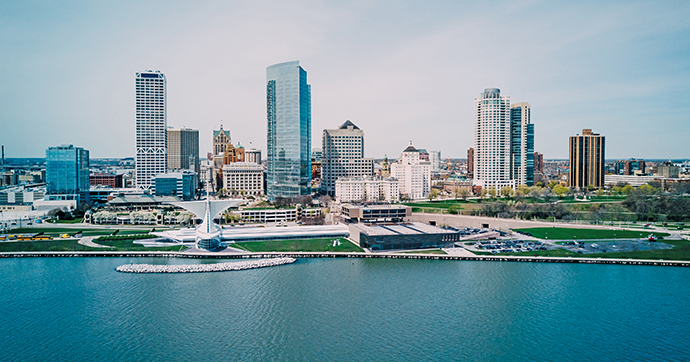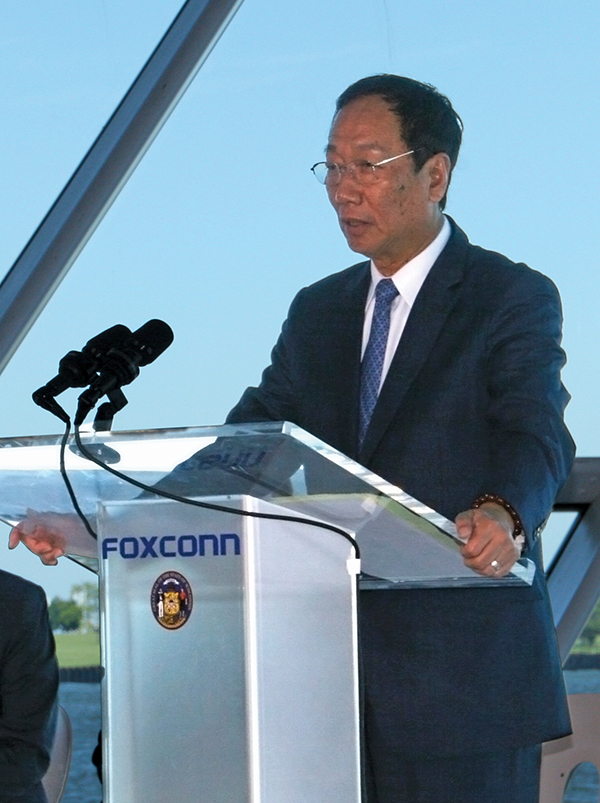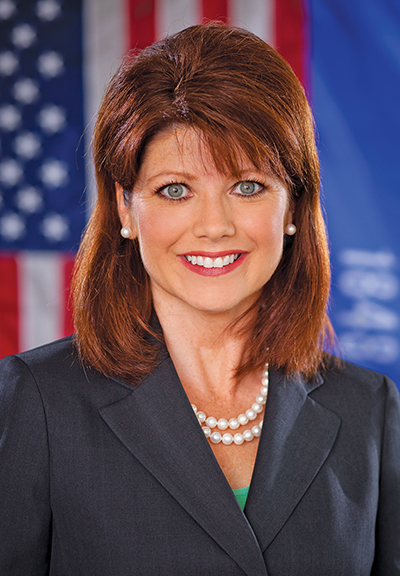Remember the big one that got away? Wisconsin doesn’t.
Landing the largest capital investment in state history has a way of erasing bad memories. In Wisconsin’s case, winning a $10-billion investment in a 20-million-sq.-ft. (1.8-million-sq.-m.)advanced electronics manufacturing complex from Taiwan-based Foxconn not only eclipses any other economic development deal in the Badger State’s past; it offers the potential to rewrite the state’s future.
“The eagle has landed, it has spread its wings, and it is taking off again,” Wisconsin Gov. Scott Walker said at the ceremony announcing the game-changing Foxconn investment at the famed Milwaukee Art Museum on the shores of Lake Michigan.
Designed by legendary architects Eero Saarinen, David Kahler and Santiago Calatrava, the Art Museum served as the perfect backdrop for the project announcement. The 8K liquid crystal display TV screens that will be assembled at the new Foxconn factories in Southeast Wisconsin will represent the latest technology in high-end electronics, and they will require the advanced skills of technically trained workers — 13,000 of them — when it opens in 2020.
When $136-billion Hon Hai Precision Industry Co. Ltd. (Foxconn) announced on July 26 that it would place its first-ever large-scale plant investment in North America in the Upper Midwest, it marked a sea change for a firm that employs 1.3 million workers worldwide. A company that made its fortune assembling Apple iPhones and other high-end electronic devices, mostly in low-wage locations in East Asia, was broadcasting to the world that it would now manufacture super-high-definition, 5G-wireless TV monitors in the United States.
How this project came about, and what it means for the future of Wisconsin and the Upper Midwest, is a story of high-stakes negotiations and deal-making that brought a lot of players to the table and resulted in one grand-prize winner: Wisconsin.
The big “W” — as in “win” — for Wisconsin is the story of seven other “Ws” — Walker, Washington, the Wisconsin Economic Development Corp., water, workforce, the Wisconsin Energy Corp., and the Wisconsin education system.
Did It Take 4 Months or 6 Years?
In deconstructing the anatomy of this complex deal, several points stand out:
- Wisconsin was neither the high bidder nor the low bidder.
- The site search in the US began on April 28 and lasted only four months — remarkable for a project of this complexity.
- Foxconn did not get everything it asked for in the negotiations.
- Foxconn selected a region but not an exact site for the facilities.
- The total jobs number increased as the project moved through the timeline.
- A key White House official was pivotal in setting up the meetings between Foxconn and the leaders of Wisconsin.
- The presence of the world’s largest supply of freshwater in the Great Lakes immediately elevated Upper Midwest locations to the top of the project short list.
Publicly, it was reported that the entire site selection process took about four months. But Wisconsin Gov. Scott Walker says he began laying the groundwork for this breakthrough deal six years ago. It began with overhauling a public policy system that had been engineered to serve the needs of a 20th-century economy, not a 21st-century one, he said.
“The overriding factor — the one that separated us from our competition — was the fact that we were ready,” Gov. Walker told Site Selection. “We changed our business climate. We cut our tax burden. We wiped out almost all the tax liability for a manufacturing project like Foxconn’s. We became a right-to-work state. We adopted regulatory reform. Some states were just not ready. I had been working on this six years ago.”


Walker met with Foxconn Technology Group Founder and Chairman Terry Gou both at the White House and at a Sharp-Foxconn facility in Japan, thanks to an assist from former White House Chief of Staff Reince Priebus of Wisconsin. Walker said it was clear that several pivotal factors sealed the deal: the overall business climate of Wisconsin; the quality of the state’s workforce; access to abundant freshwater in Lake Michigan; the partnership between state and local governments; and incentives.
The Wisconsin Assembly approved up to $3 billion in incentives for Foxconn if the company meets capital investment and hiring targets. The bill now goes before the Wisconsin Senate, which is expected to approve the legislation and forward it to Walker for his signature.
“There are clawback provisions,” the governor noted. “We pay them to grow. They must make the investment in capital and create the jobs. But the payback to Wisconsin is huge. They will add over $10.5 billion in payroll in our state over the next 10 to 15 years. A new report commissioned by the Wisconsin Technology Council shows that for every dollar the state provides in incentives to Foxconn, the deal will provide $3.90 in value back to the state. They will spend $10 billion to build this 20-million-square-foot complex. To build that requires 10,000 direct construction jobs, plus another 6,000 indirect jobs.”
The Jobs Numbers, They Are a Changin’
Walker added that he initially thought Foxconn was bringing 5,000 to 8,000 jobs. Only later did he learn that the company wanted to hire 13,000 workers in Wisconsin. On top of that, Walker says that Foxconn will spend more than $1.4 billion sourcing products and services from Wisconsin-based suppliers and create a ripple effect that’s projected to create an additional 19,000 to 26,000 jobs — beyond the 13,000 direct employees at the Foxconn campus in Southeast Wisconsin.
“The final site will be determined by access to transportation, proximity to water from Lake Michigan, workforce, and being able to put together the full acreage they need,” Walker says. “They did not announce an exact location for the plant because they want to have some leverage so that land prices do not become exorbitant.”
Gou himself said that Foxconn exercised considerable due diligence before announcing southern Wisconsin as its pick. The chairman told the Milwaukee Journal Sentinel that Foxconn wanted to be in the US because it is “still the largest consumer market in the world.”
The jobs, including engineering and other high-tech positions, will pay an average annual wage of at least $53,900 plus benefits, Gou noted. He cited other location factors as crucial:
- The presence of numerous corporate partners and potential partners in the region: Rockwell Automation, GE Healthcare, Johnson Controls and others.
- The Chicago-Milwaukee corridor is in the geographic center of the US.
- Access to Chicago’s O’Hare International Airport, Milwaukee’s General Mitchell International Airport and multiple rail lines provides transportation and logistics.
- “You have a good manufacturing foundation” in Wisconsin, Gou said.
- Wisconsin’s strong university and technical college system will play a valuable role in training the workforce of Foxconn.
- Vast energy resources — brought to the site by Wisconsin Energy Corp. — are critical.
Gale Klappa, chairman of WEC Energy Group, was part of the delegation that traveled to Osaka to meet with Gou and other Foxconn officials. “We believe, based on the projections that Foxconn provided, that the electric demand from this campus will be north of 200 megawatts,” says Klappa, who also co-chairs the Milwaukee 7 Economic Development Board. “It would be more than triple our current largest industrial customer in Wisconsin.”
Wisconsin had an edge over other states, says Klappa, because “we’ve invested more than $10 billion in the past decade to upgrade the entire energy network in Wisconsin; and we’ve been named the most reliable electric utility in the Midwest for six consecutive years.”
For a company that cannot withstand even a voltage dip during manufacturing, much less a power outage, the capacity and reliability of WEC were key selling points, notes Klappa.
Gou also credited several leaders for their work on the deal: Gov. Walker; US House Speaker Paul Ryan, whose Milwaukee-anchored Congressional District will house Foxconn; the Metro Milwaukee Association of Commerce; and the administration of President Trump.
“These key people pushed very hard,” Gou said.
They had to, because other states were pushing hard too. Ohio, Indiana, Michigan, Illinois, Texas and Pennsylvania all competed against Wisconsin in an attempt to land Foxconn. Michigan lawmakers even passed the Good Jobs for Michigan bill that would have offered substantial incentives to Foxconn.
How Wisconsin Approached the Talks
“Other states offered as much or more as we did in an incentives package,” says Walker. “Others were higher, but it was not just about the incentives. We were competitive, but other factors made the difference.”
Wisconsin Lt. Gov. Rebecca Kleefisch tells Site Selection that the effort to land Foxconn began with a meeting between Walker and Foxconn officials at the White House in April. “The Wisconsin EDC and the Milwaukee Seven Economic Development Board had heard about the project through a simple RFP, but no one knew then who the company was or how massive this project would be,” she says. “Governor Walker and Chairman Gou developed a close relationship, and they have a lot of respect for one another. Gou was impressed with the governor’s commitment and willingness to go out of his way to make Foxconn feel welcome in Wisconsin.”
Kleefisch says Walker sold Foxconn on Wisconsin’s long-term stability. “Moody’s upgraded our bond rating,” she says. “We have no unfunded pension liability, and we are one of only three states that can claim that. We are prepared to make long-term commitments to job creators.”

Still, a big goal for Wisconsin was arriving at a good deal for the state, and that’s where WEDC Secretary and CEO Mark Hogan came in, says Kleefisch. “Mark is an expert negotiator,” Kleefisch says. “He came to WEDC directly from the banking industry. He wanted to make sure that Wisconsin came out a winner. You can’t even argue that we lost. We will receive 13,000 permanent jobs and 10,000 construction jobs and a $10-billion investment. We did not meet the company’s ask. Their number was bigger than ours. We still feel that Foxconn will be a winner because they chose the right state.”
Deal critics, such as Good Jobs First’s Greg LeRoy, argue that the state paid too much. “By personally associating himself with a Foxconn announcement that has pitted several states against each other, President Trump is legitimizing a ‘race to the bottom’ as he did explicitly in his speech at Carrier [in Indiana] last December,” said LeRoy in a statement. “Instead of using his ‘America First’ frame to promote cooperation among the states, he is blessing the ‘second war among the states,’ as Business Week dubbed it 41 years ago.”
Not everyone agrees. UW-Madison economist Noah Williams, director of the Center for Research on the Wisconsin Economy, analyzed state and national studies and concluded that “Foxconn has the potential to generate broad gains that go far beyond the direct job estimates and tax revenue costs, which have dominated the recent discussion.”
Fiscal costs could be $2.84 billion in state subsidies for capital and payroll expenditures over 15 years if the Legislature approves the total incentives package. After analyzing the expected impacts of the Foxconn investment, Williams said the state could see:
- Between 32,000 and 39,000 indirect jobs through Foxconn’s supply chain and other induced activity.
- An additional $39 billion in gross domestic product, in addition to $11 billion in labor income, over 15 years.
- Fewer Wisconsin workers in Kenosha and Racine commuting across the border into Illinois each day to work.
- An increase in foreign direct investment in Wisconsin as Foxconn pulls in suppliers and related firms it deals with from around the world.
Kleefisch says the deal is already paying dividends to Wisconsin farmers. “The president of Foxconn is a huge fan of American ginseng, 95 percent of which is grown in Northern Wisconsin,” she says. “An additional MOU was signed between Foxconn and our ginseng growers. Foxconn has agreed to promote Wisconsin ginseng around the world. That’s what I call immediate ROI.”
Initial Cold Calls ‘Got Nowhere’
Jim Paetsch, vice president of corporate relocation, expansion and attraction for Milwaukee 7, tells Site Selection that the initial blind RFP for the project came in on March 9. “We sent it back on March 15,” he notes. “The RFP said they were looking for a 750-acre [304-hectare] tract, that it would be 1,000 to 2,000 jobs, and that it would be $150 million to $250 million in capex. Obviously, the deal metrics changed dramatically after that.”
An initial round of cold calls to Foxconn “got nowhere,” says Paetsch. “But once the governor met with them, that led to a very intense three months that led to the deal we announced in late July. The governor led the team, but it took a lot of effort on behalf of a lot of people.” Those included Klappa of WEC; Hogan of WEDC; and Blake Moret, CEO of Rockwell Automation. “Our electric power availability and rates were very important to Foxconn,” Paetsch adds. “They wanted to make sure that we could serve the site and deliver power at a rate that Foxconn would find competitive.”
Population was critical, he notes. “Chicago has 9.5 million people. Milwaukee has 1.6 million. Being in a corridor with access to both markets within 90 miles is a real asset,” Paetsch says. “And the two regions are starting to meld together as one. There aren’t many places in the country where you could find a 1,000-acre site within a labor shed of 11 million people.”
On August 21, Foxconn said it would begin by building three ancillary facilities as part of its new Wisconsin LCD campus. These three new plants alone would total $1 billion in investment, said Louis Woo, special assistant to Chairman Gou.
Paetsch summed up the significance of the project win by saying, “This plants Wisconsin’s flag in the digital economy of the 21st century. This is transformational for our state.”

